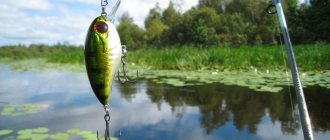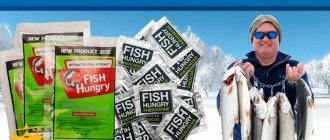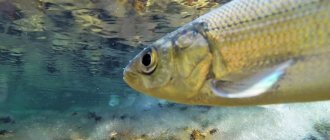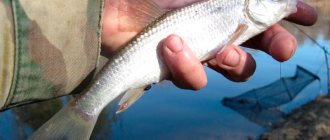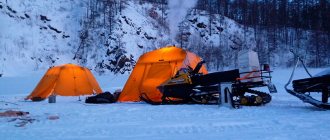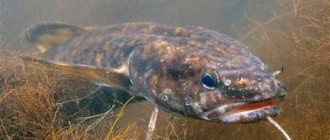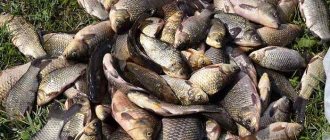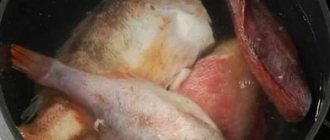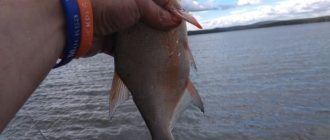Fishing is one of the main recreational options. And if you also know how to fish, then that’s great – you can get a lot of emotions, have a great time, and even catch fish. Knowledge of fishing tricks and secrets has the greatest impact on success when fishing.
Experienced fishermen know that fishing in the rain can bring a good catch. It has been repeatedly noted that fish bite better during light rain compared to clear weather. Many fishermen say that all this happens due to a noticeable cloudiness in the water. Let's figure out whether fish really bite in the rain and why this happens.
Choosing a fishing spot in rainy weather
The choice of fishing location is always one of the key factors when fishing, regardless of whether fishing occurs in rain or clear weather. When choosing a fishing spot, you should always rely on the depth of the reservoir.
Reservoirs with low water levels are not suitable for fishing in rainy weather, as too much turbidity in the water will prevent them from finding your bait. You should also not choose areas where one body of water connects to another as a place for fishing. Such places never delight fishermen with excellent fishing.
Choose deep lakes for fishing, with a depth of about 5-6 meters.
Can pike be caught in the rain?
Constant light rain is the best condition for pike fishing. At the same time, it is important that the precipitation does not intensify or pause and create characteristic ripples on the water.
When the sky is overcast with clouds, moderate illumination is formed; the light flickers due to ripples on the water and partially disorients the fish. The predator perceives the bait as a real fish, is easily deceived and replenishes your catch.
What is the best way to catch fish? Experienced fishermen recommend using polished, bright and shiny baits, silver or gold in color. Don't forget about the size - they should be large. For example, large wobblers or bright oscillating spoons. Pike bite best on them in the rain. Those designed for wiring at medium depths are also suitable.
About
Temperature and wind during rain
Also, important factors are the ambient temperature in combination with the wind. A south or west wind combined with warm rain and excellent ambient temperatures will definitely bring you results.
With this combination of factors, the fish exhibits maximum activity. It’s especially good in such weather to go fishing for ide or perch; the pike bites a little worse, but still good. A change in wind direction and a drop in temperature can lead to only one thing - the fish will simply lie to the bottom.
In cold rain the fish don't bite.
Fishing after the rain - what could be better!
After continuous rain, strong thunderstorms and lightning and other weather phenomena, including hail, it was finally over, the dark clouds cleared, the rain stopped, and the weather returned to normal. The next day I decided to go fishing, the long-awaited fishing that I had been looking forward to so much and nothing could stop me from going on it! In the evening I collected my gear, prepared bait and everything else. I set the alarm for 03:00 in the morning and without wasting time went to bed.
My sound sleep, in which there were so many dreams and so many record trophies, was interrupted by the alarm clock and woke me up, 10 minutes to get ready and I’m going fishing, the road takes a little time, but after such long rains, the path is a little difficult, branches with trees are fallen, heavy mud, impassable in places.
I'm finally here. It gets light early, so without wasting a minute I prepare the bait. I use a purchased FishDream bait mixture, adding boiled pearl barley to it for gluing so that it holds on to the current more firmly, then I add a little vanilla, and gradually mix it all with the addition of a small amount of water. Groundbait is involved. While it sits, I begin to disassemble the gear. I use inexpensive rods because I don’t go fishing very often.
I use rods of different lengths for different casting distances. 1 rod - Crocodile 2.70 with test weight up to 250 grams, an inexpensive reel, the simplest and most uncomplicated, fishing line 0.28 and Paternoster equipment. 2 rod - Tele spin 2.10 with test up to 60 grams, 0.14 braid, Gardner loop rig. As bait and bait I use worms, maggots, pearl barley, and corn. I decide to experiment with baits, since on previous fishing trips I only caught small fish with a worm, I enlarge the bait, make a sandwich of a worm and pearl barley on the 1st rod and maggot and corn on the 2nd rod. I throw gear at different distances. The gear is abandoned. We are waiting for a bite. It's already 04:00.
Fishermen hunting for predators swim past, they float downstream and fish different parts of the river in search of a predator.
A flock of wild birds flies by. There is beauty all around, the weather is whispering, there are still no bites, I decided to replant the tackle, changed the nozzle, filled the feeders with bait, cast it again, waiting for a bite...
After 1 hour, there was 1 bite of a medium-sized fish, it was a small bluegill, despite changing the nozzle, casting the gear close or far, nothing helped, the fish was inactive, and for some reason ignored everything that the fishermen offered it, even in the neighborhood the sitting fishermen did not see any bites, they only hoped in anticipation that a bite was about to happen, but nothing happened. Hours of waiting passed, some fishermen were not in a very good mood leaving home, others were waiting for their first bite, the weather was constantly changing, then the sun would appear, then clouds would appear, a wave would roll in, it would begin to rain, all the fishermen sitting on the shore would go home, so and without waiting for a bite, I decided to stay and still try my luck, even if I didn’t catch anything.
I decided to get my gear, changed the nozzle to a new one, added a little honey to the bait, put the bait in the feeder and began throwing the gear further than previous times, throwing it at 40-50 meters. I installed bells as a signaling device. A few minutes after the cast there was a long-awaited, sharp and confident bite, a hook, and there was something good on the hook, a little fishing, I took the landing net, put the fish in it and that’s it, it was caught. I caught a good crucian carp. I make a second cast to the same place, not even a minute goes by with a sharp bite, a hook, and there’s a pretty good weighty crucian carp on the hook. So far the bites are on 1 rod (2.10 with a test weight of up to 60 grams), the other rod is silent and does not “make” a single sound about the presence of fish.
It was 11:00 and the fish just started to become more active, the weather was not the best, what can you do to catch fish... A strong wind was blowing, it was drizzling, there was a wave, and the bites one after another, like from a machine gun, it was indescribable . Sometimes, having thrown the tackle and not yet waiting for the feeder to sink to the bottom, I received a bite, and without any poking or shaking, but sharp and confident, probably the fish lined up and was waiting for its food. In 1 hour I managed to catch good, selected crucian carp, from 300 grams and more, I have not seen such a bite for a long time, and the fish were caught with one tackle.
It’s a pity that the weather only got worse and clouds appeared... I began to get ready to go home.
Well, why not have a photo shoot with fish, this is a must, no matter what the weather is like.
This is what I managed to catch in 1 hour of fishing, despite the bad weather. I am very pleased with the fishing, and the bites are simply indescribable, how sharply the bell rings, how the rod bends in an arc, what jerks of the rod, and what kind of fighting, the fish resists, sometimes jumping out of the water, all this turns on the soul and you can’t take your eyes off it.
I “loaded” the fish into the cage and decided to weigh it. I carry everything I need for fishing with me. I took the scales and weighed it: the total catch was 5 kilograms, I am very happy about the fishing, it was unusual, there were cliffs and hours without biting, but in the last hour of fishing the weather changed and the fish began to be actively caught. I loaded the catch into my backpack, collected my gear and headed home.
I take one last photo as a souvenir and head home.
On the way home I photograph the landscape of the Khopyor River. I wish you, friends, frequent fishing trips worthy of trophies. Experiment with baits and baits and you will succeed, NHNCH!
Features of fishing in the rain
The main feature that distinguishes fishing in the rain is the minimum number of idle bites. When it rains, your bait will not remain motionless in the water, which causes the fish to swallow it very greedily. The chances of catching large fish, in particular bream, also increase. During high tide, increased activity of aquatic life has also been observed.
Wave height plays a big role when fishing in the rain.
Strong waves significantly reduce the fish bite, since at depth the bait moves too often in a vertical position. If there is also a strong east wind, then there will definitely not be successful fishing.
First of all, fishing in the rain should be fun, so a waterproof raincoat, rubber boots and warm clothes will be very useful. The key to successful fishing is always the correct equipment and choice of gear.
Features of fishing in different months
The general characteristics of autumn fishing include several features.
- At this time, the basis of the white fish “menu” is various larvae and insects caught at the bottom of reservoirs.
- The water in the waters gradually cools down, so the fish become less active.
- As the algae drop and the air cools, the water becomes more transparent. This means that the time has come to install inconspicuous thin gear.
- Over the summer, the fish have already gained significant weight and do not notice every bait. A fisherman cannot do without cunning and patience.
- Fish migrate throughout the water area. When it's warm, the potential catch moves closer to the shoreline, and when it rains, it goes back to the bottom.
In September
The summer behavior of fish is characterized by invariability until the water temperature in the water area drops to +10, although in a certain way it also depends on the weather. If it's warm and dry, you can expect a good bite, like in the summer. With the onset of cold weather, only 2 obvious bite peaks can be identified - in the morning and in the evening.
From September it’s time to change your fishing strategy. Deep holes, creeks and all rifts need to be examined as a priority. Fishing from the shore is less productive than from a boat. Now you can perfectly catch predatory fish with a spinning rod, but with summer gear you can still catch peaceful ones. It is advisable to use animal baits, and the bait should not give off a strong smell. Several calm, cloudy days in a row are considered ideal natural conditions for September fishing.
In October
Water temperature ranges from +10 to +4. Vegetation gradually dies off, the water is purified, and plankton is sent to the deeper layers. Which means that the food supply for most fish has changed. Carp become inactive as the water cools, predatory species follow their prey and their activity also decreases.
Frequent rains have a bad effect on the bite, and regularly changing pressure has a bad effect on the fish. It is advisable for a fisherman to acquire a barometer. In October, predators actively peck and begin to eat more often and more. A float rod and a spinning rod are the main gear for October. Perch and pike are great for catching with fry, but roach prefers the taste of maggots.
In November
The water temperature drops below +4. The fish is preparing to spend the winter. Large cyprinids gather in large schools in underwater holes; they will not be stirred up for the next 3 months. Small specimens of roach and crucian carp still feed in the shallows area all day and in the evenings, and a predator always lives not far from them. Fans of fishing in late autumn conditionally divide it into the following periods:
- before ice forms;
- freezing;
- appearance of the first ice.
Watch the video about fishing on the feeder in the fall.
Does the bite increase after rain?
It has been noticed that the fish begin to bite during the rain, and after it ends, the bite only intensifies. Many fishermen are puzzled by the reasons for the increase in fish activity associated with changing weather. But it's quite simple to explain:
- The oxygen level in the water only increases after the end of precipitation.
- The increase in atmospheric pressure that occurs after rain also has a great effect on fish biting.
- The ions that saturate the water of the reservoir along with rainwater provoke the fish to become active.
Of course, this doesn’t mean that while fishing in the rain or after it, the fish will bite like crazy. Without the right tackle, bait and choosing the right fishing technique and tactics, you are unlikely to be able to please yourself with a good catch.
Tips for fishing in the rain
- If it was very hot outside before the rain, the fish will start biting with the first drops. Saturation with oxygen and a decrease in water temperature in the reservoir makes the fish bite more actively.
- If during the rain you notice that the water in the reservoir has become cloudy, but not very cloudy, there will definitely be a bite. But with a lot of cloudiness there will be no bite.
- Choose a secluded place for fishing that can protect you from strong wind gusts.
- The deeper the reservoir, the better.
- Before heavy rain, the atmospheric pressure gradually decreases, and for fish this is an excellent call to bite.
